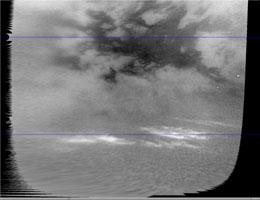
Click on the image for the movieThis video demonstrates the hiss-like radio noise generated by electrons moving along magnetic field lines from the Saturnian moon Enceladus to a glowing patch of ultraviolet light on Saturn.
The data from the radio and plasma wave science instrument aboard NASA's Cassini spacecraft cover a period from 6:02 p.m. to 6:17 p.m. PST on Nov. 20, 2009 (2:02 a.m. to 2:17 a.m. UTC on Nov. 21, 2009). This Enceladus flyby brought the spacecraft within about 1,800 kilometers (1,100 miles) of the moon.
The sound is typically inaudible to the human ear, but has been amplified electronically.
The colors in the video indicate the intensity of the electron bombardment. Red is the most intense.
This hiss-like noise created by the electrons is one sign of the magnetic connection between Saturn and Enceladus, which also creates a glowing ultraviolet "footprint" near Saturn's north pole. Electron beams detected by the Cassini plasma spectrometer and magnetic field disturbances detected by Cassini's magnetometer also provided signs of the electrical circuit between Saturn and Enceladus.
The Cassini-Huygens mission is a cooperative project of NASA, the European Space Agency and the Italian Space Agency. NASA's Jet Propulsion Laboratory, a division of the California Institute of Technology in Pasadena, Calif. manages the mission for NASA's Science Mission Directorate, Washington, D.C. The radio and plasma wave science team is based at the University of Iowa, Iowa City.
For more information about the Cassini-Huygens mission visit http://www.nasa.gov/saturn and http://www.nasa.gov/cassini.

